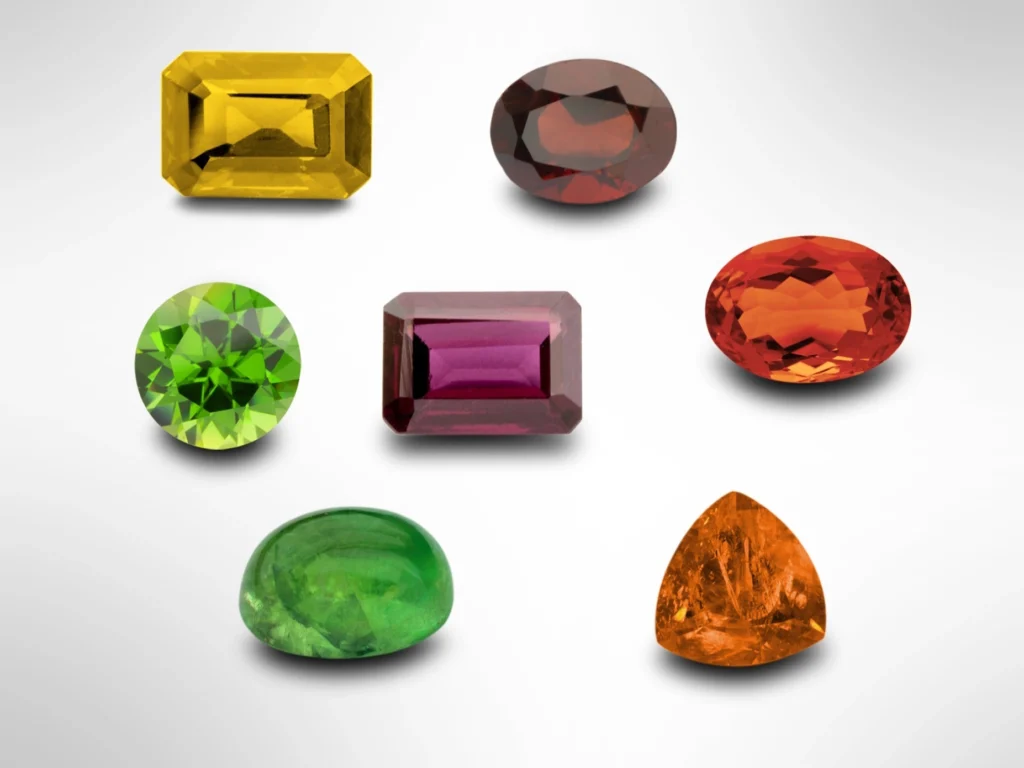Garnets: Beyond Rubies, Pomegranates, and Their Rising Popularity

By Ramit Kapur, MD, Gemological Science International (GSI)
When we think of garnets, the image of a deep red gemstone resembling pomegranate seeds often comes to mind—a reflection of its etymology from the Latin word granatus, meaning “with many grains.” This nods to the resemblance between the gem’s typical red color and pomegranate seeds. But as someone who has witnessed the jewelry industry’s evolution from a front-row seat, let me tell you: garnets are far more than a red stone with a pretty backstory.
Garnets: More Than a Ruby Substitute
Today, garnets have shaken off the “affordable ruby substitute” label and emerged as dynamic players in the global gemstone market. From fiery reds to lush greens and brilliant oranges, garnets demand attention—not as imitators, but as headliners.
The Shift: Diamonds to Color, Color to Personality
In recent years, consumer preferences in jewelry have undergone a dramatic transformation. The universal appeal of diamonds, once unchallenged, is now complemented, and sometimes eclipsed, by the rising demand for colored gemstones. Buyers are increasingly drawn to vibrant stones that tell a story, reflect their personality, and stand out in a crowd.
Garnets in the Spotlight
Garnets, often overlooked in the past, are now finding their moment. Whether for engagement rings, heirlooms, or red-carpet statements, these stones are challenging traditional notions of luxury. Celebrities and designers alike are embracing bold varieties like tsavorites and demantoids, which rival—and often surpass—precious stones like emeralds in brilliance and allure.
A Pragmatic and Aesthetic Shift
This shift isn’t just aesthetic; it’s pragmatic. The high cost and limited availability of rubies and other precious stones, coupled with ethical and sustainability concerns, have pushed consumers toward equally stunning alternatives. Garnets, with their vivid hues and rich history, have answered that call.
A Market on the Rise
The global garnet market size was USD 390.64 million in 2021 and is expected to reach USD 774.34 million in 2031, exhibiting a CAGR of 7.08%. This growth is driven by increasing demand in both industrial and jewelry applications. While industrial demand historically dominated the market, the jewelry segment is witnessing exponential growth, with North America expected to hold the largest share.
Regional Insights and Market Drivers
Garnets are finding their stride across global markets due to their versatility, affordability, and stunning appeal:
- Europe: Known for its appreciation of heritage and craftsmanship, Europe favors rare varieties like demantoids and tsavorites.
- America: A clear preference for personalized and sustainable jewelry makes garnets popular for engagement rings and statement pieces.
- Asia-Pacific: Particularly in India, garnets are sought after in bridal and festive collections for their beauty and accessibility. In China, a growing middle class is embracing garnet jewelry as a unique alternative to traditional gemstones.
Rising Stars: Demantoid and Tsavorite Garnets
Among garnets, demantoids and tsavorites have garnered a cult following:
- Demantoids: With vivid green hues and extraordinary brilliance, they rival top-tier emeralds. Their signature “horsetail inclusions” are prized among collectors.
- Tsavorites: Discovered near Kenya’s Tsavo National Park, they are a designer favorite for their vibrant green hue, durability, and natural brilliance.
Beyond Red and Green: The Diversity of Garnets
Garnets are not confined to red and green. Varieties like orange spessartine, pinkish-orange malaya garnet, and purple rhodolite are gaining traction among collectors and designers. Each variety has a unique personality and story, enriching the jewelry narrative.
Inside the Lab: The Science of Garnets
At GSI, garnets arrive with fascinating histories. Unlike many gemstones, garnets are typically untreated, enhancing their appeal among purists. However, their diversity presents unique challenges for gemologists.
Unique Characteristics of Popular Garnets
- Demantoids: Known for their fire and “horsetail inclusions,” these reveal their source and rarity.
- Tsavorites: Prized for their durability and subtle chromium or vanadium zoning.
- Hessonite: Recognizable for its warm orange tones and signature “treacle effect.”
The Future of Garnets
Garnets are redefining modern luxury. From affordable substitutes to coveted collectables, their journey exemplifies timeless appeal and boundless potential. For those willing to look beyond the usual, garnets offer a treasure trove of possibilities.
About GSI:
Gemological Science International (GSI), headquartered in New York, is a leading global gemological laboratory renowned for its innovative services and high-quality standards. Operating across key markets like Hong Kong, Dubai, and India, GSI provides accurate grading and assessment of diamonds, gemstones, and jewelry. As an RJC-certified organization, GSI is trusted for its industry solutions, fast turnaround times, and consistent certification. Its unique “One World One Report” system ensures global transparency through centralized management and uniform processes.
About Ramit Kapur:
With over 28 years in the gems and jewelry industry, Ramit Kapur leads GSI India with a focus on innovation, quality, and education. He has advanced gemological standards in India, expanded GSI’s global footprint, and embraced technology to ensure cutting-edge services. His expertise spans diamond sourcing, manufacturing, retail, and education, honed through roles with industry leaders like Rose Group and Alex Primak. A collaborative leader, Kapur fosters continuous improvement and client-centric solutions, driving excellence in every endeavor.


